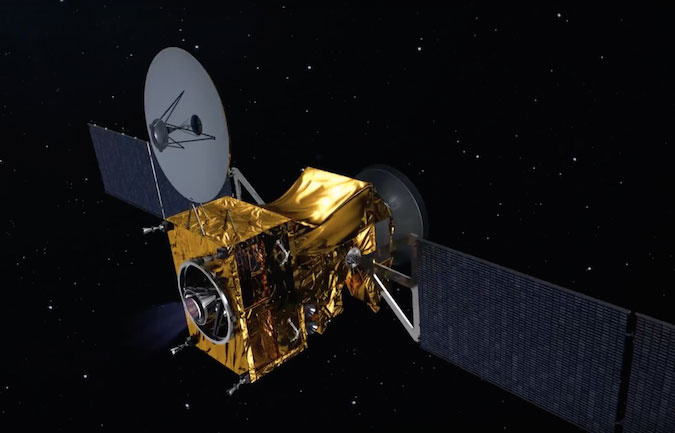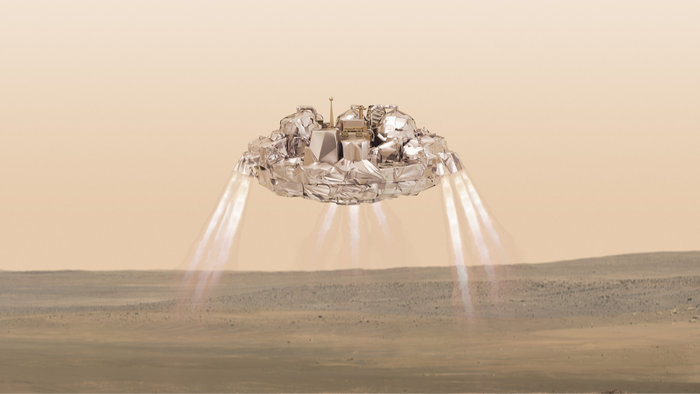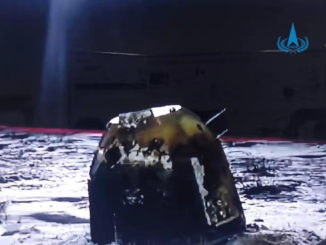
A European spacecraft cruising toward Mars fired its main engine Thursday, tweaking its trajectory and helping set up for carefully-choreographed simultaneous maneuvers Oct. 19 to place part of the tandem mission into orbit around the red planet and deposit a stationary battery-powered lander on the Martian surface.
Composed of an orbiting mothership fitted with scientific instruments and the Schiaparelli landing module, the ExoMars spacecraft ignited its main engine at 0930 GMT (5:30 a.m. EDT) Thursday for 52 minutes, the European Space Agency said.
Generating about 95 pounds of thrust, the engine was supposed to adjust the spacecraft’s velocity by about 730 mph (326.5 meters per second), providing most of the required impulse to aim for Schiaparelli’s landing in Meridiani Planum.
“Today’s burn was the biggest of the four planned that will enable ExoMars to intercept Mars and precisely deliver the Schiaparelli lander on 19 October onto Meridiani Planum, a large, flat region near the equator,” said Michel Denis, ExoMars flight director at the European Space Operations Center in Darmstadt, Germany.
Thursday’s deep space maneuver — planned since before the mission’s March 14 launch — provided about 95 percent of the propulsive force needed to correct the ExoMars spacecraft’s trajectory.
A “clean-up” maneuver is planned Aug. 11 to do most of the remaining work to guide Schiaparelli toward its landing site. Even smaller trim maneuvers are scheduled for Sept. 19 and Oct. 14 before the ExoMars Trace Gas Orbiter and Schiaparelli lander separate Oct. 16.
Around 12 hours after the lander deploys, the orbiter will fire its engine again to get on the correct path to enter orbit around Mars. A lengthy 134-minute main engine firing Oct. 19 will slow the probe’s speed enough for Martian gravity to capture it into orbit.
Measuring nearly 8 feet (2.4 meters) in diameter with its heat shield, the saucer-shaped Schiaparelli probe will plunge into the atmosphere during the make-or-break engine firing aboard the Trace Gas Orbiter, making the events of Oct. 19 doubly important.
While its engine is burning for the critical orbit insertion maneuver, the ExoMars mothership will listen for status signals radioed from the descending Schiaparelli lander, Denis said.
“At the same time, TGO is flying over and with its radio provided by NASA will be recording the signal of the entry, descent and landing of Schiaparelli … And it will nonetheless continue burning up to the moment when the burn is finished,” Denis said.
Giant 230-foot (70-meter) dish antennas from NASA’s Deep Space Network will support the ExoMars mission’s arrival, and an array of 30 radio telescopes in India will also listen for confirmation of Schiaparelli’s landing.
Europe’s Mars Express orbiter and NASA’s Mars Reconnaissance Orbiter will help relay signals from the Schiaparelli lander after touchdown.
“It’s a huge ballet, a huge coordinated dance that will take place in these couple of days,” Denis said.
As of Thursday, the ExoMars spacecraft had traveled about 208 million miles (335 million kilometers) since its March liftoff aboard a Russian Proton rocket, arcing away from the sun from Earth to intersect Mars’ orbit in October.
By the time it arrives at Mars, the craft will have traveled 308 million miles (496 million kilometers), according to ESA.

Equipped with a downward-facing descent camera and a weather station, Schiaparelli is primarily a technology demonstrator with a prime objective of proving out heat shield, parachute, radar altimeter, and computer systems for use on future Mars missions.
ESA plans to employ the same radar and computer design on a more ambitious joint European-Russian Mars lander to launch in 2020. That will be the second phase of the two-part ExoMars mission.
If successful, the Italian-built Schiaparelli probe would become the first European spacecraft to set down on Mars and return data. The UK-led Beagle 2 lander touched down on Mars in 2003, but ran into trouble before it could contact Earth.
Schiaparelli should operate on the Martian surface for several days, and perhaps up to a week, before its batteries run out of power.
Meanwhile, the Trace Gas Orbiter will swing into a preliminary oval-shaped pathway around Mars taking the craft nearly 60,000 miles (96,000 kilometers) from the planet at its highest point.
Next year, the orbiter will begin a series of dips into the outer layers of the Martian atmosphere, encountering air drag to reshape its course into a circular 250-mile-high (400-kilometer) orbit. The “aerobreaking” phase of the mission should be complete by November 2017, allowing the mission to commence regular science observations by the end of next year.
The spacecraft’s main purpose is to measure and map concentrations of trace gases, such as methane, in the Martian atmosphere, which could be an indicator of active geology or microbial life on the red planet. It will provide data 1,000 times more accurate than existing trace gas measurements, according to ESA, and help identify where sources of Martian methane, water vapor, acetylene, and other gases are located.
Assembled by Thales Alenia Space in Cannes, France, the Trace Gas Orbiter also carries a camera to create maps of Mars, and a Russian instrument will locate hydrogen hidden a few feet in the Martian crust, revealing sites where water-ice deposits might be reachable by future human prospectors to turn into air, drinking water, or rocket fuel.
A third goal of the mission is to pass commands and scientific data between Earth and rovers exploring the surface, including the ExoMars rover due for launch in 2020 and NASA’s multiple landers.
The ExoMars orbiter’s mission is slated to last through at least 2022.
Email the author.
Follow Stephen Clark on Twitter: @StephenClark1.



